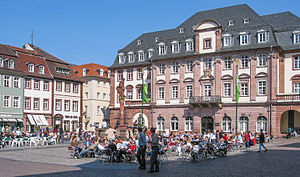Wikipedia:WikiProject Germany/Portal:Baden-Württemberg
Introduction

Baden-Württemberg (/ˌbɑːdən ˈvɜːrtəmbɜːrɡ/ BAH-dən VURT-əm-burg, German: [ˌbaːdn̩ ˈvʏʁtəmbɛʁk] ⓘ), commonly shortened to BW or BaWü, is a German state (Land) in Southwest Germany, east of the Rhine, which forms the southern part of Germany's western border with France. With more than 11.07 million inhabitants across a total area of nearly 35,752 km2 (13,804 sq mi), it is the third-largest German state by both area (behind Bavaria and Lower Saxony) and population (behind North Rhine-Westphalia and Bavaria). As a federated state, Baden-Württemberg is a partly-sovereign parliamentary republic. The largest city in Baden-Württemberg is the state capital of Stuttgart, followed by Mannheim and Karlsruhe. Other major cities are Freiburg im Breisgau, Heidelberg, Heilbronn, Pforzheim, Reutlingen, Tübingen, and Ulm.
What is now Baden-Württemberg was formerly the historical territories of Baden, Prussian Hohenzollern, and Württemberg. Baden-Württemberg became a state of West Germany in April 1952 through the merger of South Baden, Württemberg-Baden, and Württemberg-Hohenzollern. These three states had been artificially created by the Allies after World War II out of the existing traditional states by their separation over different occupation zones.
Baden-Württemberg is especially known for its strong economy with various industries like car manufacturing, electrical engineering, mechanical engineering, the service sector, and more. It has the third-highest gross regional product (GRP) in Germany. Part of the Four Motors for Europe and located in the Blue Banana, some of the largest German companies are headquartered in Baden-Württemberg, including Mercedes-Benz Group, Schwarz Group, Porsche, Bosch and SAP.
The sobriquet Ländle, a diminutive of the word Land in the local Swabian, Alemannic and Franconian dialects, is sometimes used as a synonym for Baden-Württemberg. (Full article...)
Selected article

Maultaschen (singular ⓘ) is a traditional German dish that originated in the region of Swabia (in Baden-Württemberg). It consists of an outer-layer of pasta dough which encloses a filling traditionally consisting of minced meat, smoked meat, spinach, bread crumbs and onions and flavoured with various herbs and spices (e.g. pepper, parsley and nutmeg).
Maultaschen are similar to the Italian ravioli but are typically larger in size—each Maultasche being approximately 8-12 centimeters (3-5 inches across). They are almost invariably square or rectangular in shape.
On 22 October 2009, the European Union recognized Maultaschen (Schwäbische Maultaschen or Schwäbische Suppenmaultaschen) as a "regional specialty" and remarked that the dish is significant to the cultural heritage of Baden-Württemberg. This measure provides protection to the integrity of the dish, mandating that genuine Maultaschen are only produced in Swabia, a historical region that was incorporated into the modern German states of Baden-Württemberg and Bavaria.
Selected biography

Hans Bayer, known by the pseudonym Thaddäus Troll, (18 March 1914 – 5 July 1980) was a German journalist and writer and one of the most prominent modern poets in the Swabian German dialect. In his later years he was also an active campaigner for libraries and for support, pension rights and fair publishing contracts for writers. He was born in Bad-Cannstatt, a suburb of Stuttgart and committed suicide there at the age of 66. The literary award, Thaddäus-Troll-Preis, is named in his honour. His family had a soap-making business in the town. After he finished his secondary education at the Johannes-Kepler-Gymnasium, he worked briefly as a volunteer at a newspaper in Cannstatt. He then studied German, art history, comparative literature, theater, and journalism at the universities of Tübingen, Munich, Halle, and Leipzig, receiving his doctorate in 1938 from Leipzig University.
State facts
- Nickname: Ländle
- Capital: Stuttgart
- Minister-president: Winfried Kretschmann
- Governing parties: Greens / CDU
- Total area: 35,751 km2 (13,804 sq mi)
- Population: 10,879,618 (2015)
- Founded: April 25, 1952
- Website: www.baden-wuerttemberg.de
Selected image
Did you know?

- ...that Oberried is home to the Barbarastollen caves, the central safekeeping archive of Germany. The Barbarastollen holds microfilms with millions of images from German archives and museums. The entire complex is buried under 400 meters of rock. It is intended to survive a nuclear war.
- ...that the civic symbol of Mannheim is der Wasserturm, a Romanesque water tower completed in 1886 that rises to 60 metres above the highest point of the art nouveau area Friedrichsplatz.
Subcategories
Selected panorama
 |
Heidelberg is a college town in Baden-Württemberg situated on the river Neckar in south-west Germany. At the 2015 census, its population was 156,257, with roughly a quarter of its population being students. A former residence of the Electorate of the Palatinate, Heidelberg is a popular tourist destination due to its romantic cityscape, including Heidelberg Castle, the Philosophers' Walk, and the baroque style Old Town.
Topics
Related portals
Associated Wikimedia
The following Wikimedia Foundation sister projects provide more on this subject:
-
Commons
Free media repository -
Wikibooks
Free textbooks and manuals -
Wikidata
Free knowledge base -
Wikinews
Free-content news -
Wikiquote
Collection of quotations -
Wikisource
Free-content library -
Wikiversity
Free learning tools -
Wikivoyage
Free travel guide -
Wiktionary
Dictionary and thesaurus
















